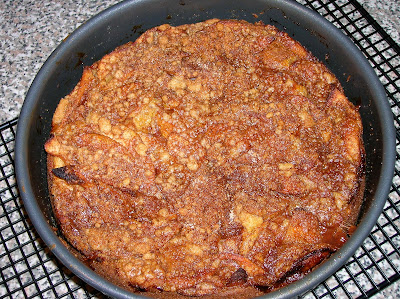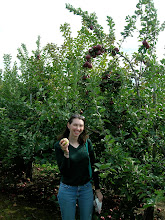Yes, you read that correctly. Pork was in my kitchen. I have had very few experiences with pork, but none of them have been particularly tasty. In fact, most of the pork dishes I've tried were rather taste-less. I saw this stir fry recipe in my Bon Appetit Fast Easy Fresh cookbook a LONG time ago and wrote it down on a sticky note on the inside cover. I knew I would find it later :)
It calls for pork tenderloin which is one of the grossest looking items in the meat department. Plus they come in three pound packages and I only wanted half a pound. So I ended up buying tender chops.
I marinated them for an hour in a mixture of soy sauce, honey, minced fresh ginger, and crushed red pepper flakes.

I cooked the pork in a dry wok because the recipe said nothing about oil for this part. But when it came time to "wipe skillet clean" I couldn't. There were black crusties cemented to my non-stick wok. I washed and scrubbed and finally gave up.
Next I whisked together the extra marinade, orange juice, cornstarch, and red wine vinegar (it was supposed to be rice vinegar, but the last thing I need is another bottle of vinegar that I rarely use in my cabinet.) I cooked some frozen french cut green beans in peanut oil, then I added the pork back in along with orange zest, minced garlic, and the whisked liquids.
I waited until the sauce thickened, which also meant waiting until the green beans were thoroughly overcooked.
We spooned the stir fry over rice and chowed down. It was good, but a little bland. I'm starting to learn something. Maybe it's because I've watched a gazillion episodes of Top Chef where the judges complain about underseasoning. When a recipe says "season to taste" that means sprinkle some salt and pepper and then actually taste it! It seems obvious, but I'm just now understanding that it is very important. Salt brings out the flavor of things, so without it, food tastes bland. I think my fear of adding too much salt has made a lot of my dishes just ok, when they could be good. I'm trying to conquer this silly little fear of mine.

In case you were wondering, that is a Mary Englebreit "Congratulations" plate. We keep this plate at the bottom of our stack of normal dinner plates, so when we get to it, it's kind of like, "Congratulations: You've used all your plates! Now run the dishwasher!"



















